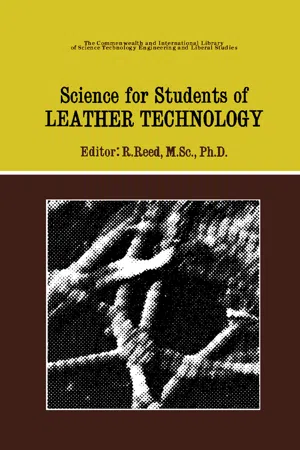
Science for Students of Leather Technology
The Commonwealth and International Library: Technology Division a Modern Course in Leather Technology
- 288 pages
- English
- PDF
- Available on iOS & Android
Science for Students of Leather Technology
The Commonwealth and International Library: Technology Division a Modern Course in Leather Technology
About This Book
Science for Students of Leather Technology is the first of a series of textbooks of leather science and technology designed to assist students at technical colleges and institutes as well as at universities. The book begins with an introduction to leather manufacturing. This is followed by separate chapters on the physical chemistry of solutions needed by students of leather manufacture; types of macromolecules; lipids and their use at various stages of leather manufacture; and the principles of their use as surface agents. Subsequent chapters deal with the general features of skin as an organ; how the skins from different animals may develop their special characteristics; common problems arising from insects and from micro-organisms in leather manufacture; and the structure and reactions of chromium complexes, which are the most widely used tanning agents; and modern views on the structure of the vegetable tannins and of the dyestuffs and pigments. This book is intended for students with a variety of backgrounds. Those whose chemical studies have not proceeded much beyond the elementary level will find considerable difficulty with some sections, especially where the organic chemistry of complex molecules (proteins, carbohydrates, dyes and vegetable tannins) is described. It is, however, possible to supplement the explanations given by reference to standard chemical textbooks, using the subject matter of the present volume as a guide to those sections which would repay further study.
Frequently asked questions
Information
Table of contents
- Front Cover
- Science for Students of Leather Technology
- Copyright Page
- Table of Contents
- Foreword
- CHAPTER 1. Introduction
- CHAPTER 2. Basic Physical Chemistry
- CHAPTER 3. Macromolecules: Proteins and Carbohydrates
- CHAPTER 4. Lipids (Oils, Fats and Waxes)
- CHAPTER 5. Surface Physical Chemistry
- CHAPTER 6. Skin Structure and the Chemistry of Collagen
- CHAPTER 7. Insects and Micro-organisms
- CHAPTER 8. The Chemistry of Mineral Tannage
- CHAPTER 9. Vegetable Tannins and Syntans
- CHAPTER 10. Dyestuffs and Pigments
- Index